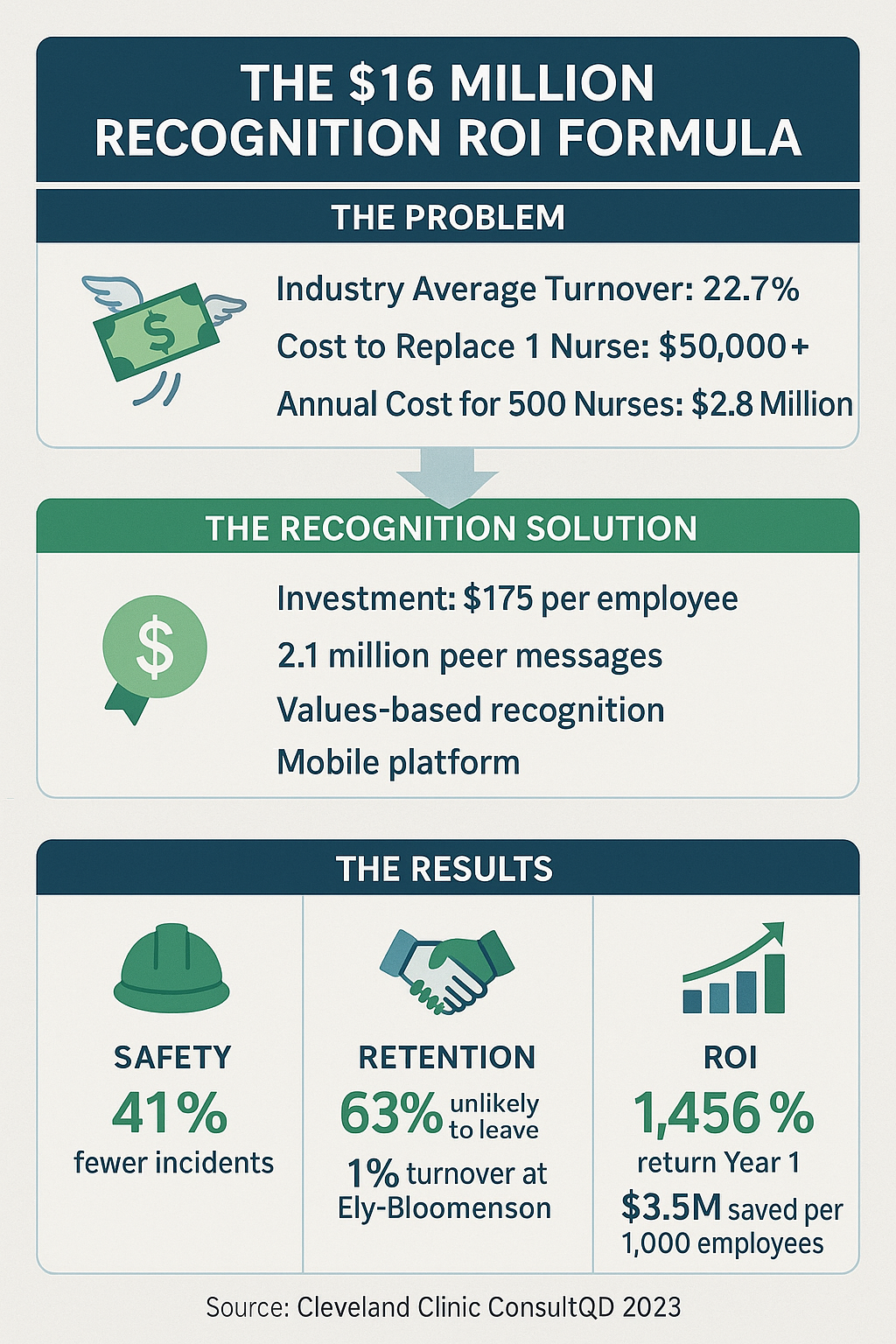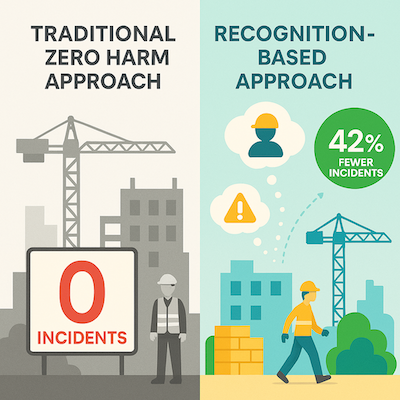Healthcare faces a retention crisis that costs organisations millions annually. Yet Cleveland Clinic's 'Caregiver Celebrations' program demonstrates a proven solution: their system has facilitated 2.1 million recognition messages since 2010, with 18% annual growth in recent years, correlating with a 41% reduction in patient safety incidents (Cleveland Clinic ConsultQD, "Building a Culture of Recognition," 2023).
For aged care providers navigating workforce shortages and budget constraints, these numbers reveal more than feel-good metrics—they represent a reproducible formula for transforming both culture and financial outcomes.
The True Cost of Healthcare Turnover
The healthcare industry's average turnover rate sits at 22.7%, according to the 2022 NSI Nursing Solutions National Healthcare Retention & RN Staffing Report. Each registered nurse who leaves costs organisations $50,000 or more to replace when factoring in recruitment, onboarding, training, and lost productivity during the learning curve.
For a healthcare organisation with 500 nurses, this translates to potential annual turnover costs of $2.8 million at industry-average rates. Scale that to larger organisations, and the numbers become staggering.
Cleveland Clinic's data offers a compelling counter-narrative. Their research shows that 63% of employees receiving regular recognition report being unlikely to seek new employment within 3-6 months (Cleveland Clinic ConsultQD organizational reports, 2023). Even more dramatically, Ely-Bloomenson Community Hospital, a Cleveland Clinic affiliate, achieved turnover of just 1% after implementing comprehensive milestone celebrations and values-based recognition—a 95.6% improvement over industry averages.
The Safety Dividend: When Recognition Prevents Incidents
Beyond retention, Cleveland Clinic's data reveals that highly engaged caregivers—those receiving regular recognition—correlate with 41% lower patient safety incidents and 15% better patient experience scores (Cleveland Clinic ConsultQD organizational reports, 2023).
This finding aligns with broader research. The NHS Barts Health Trust's 'Barts Hearts' peer recognition program not only generated 21,333 messages in its first four weeks but also correlated with improved safety reporting. A parallel program at CHRISTUS St. Michael Health System achieved a 6x increase in near-miss reporting, indicating improved psychological safety where staff feel valued enough to report problems without fear (NHS Employers, "Getting to the Heart of Peer-to-Peer Recognition," 2023).
The connection makes intuitive sense: recognised employees feel psychologically safe to speak up about risks, engaged in preventing incidents rather than merely complying with protocols, and committed to organisational excellence beyond minimum requirements.

Values Alignment: The Multiplier Effect
Cleveland Clinic's approach reveals a critical insight for faith-based aged care providers: 85% of employees feel satisfied with simple 'thank you' messages when those acknowledgments connect their work to organisational purpose (Cleveland Clinic ConsultQD, "Building a Culture of Recognition," 2023).
Every recognition in Cleveland Clinic's system explicitly links to their mission "to care for the life, health and wellbeing of the whole person." This values-based approach transforms transactional appreciation into meaningful affirmation of calling—particularly powerful in healthcare where workers often choose their profession from a sense of vocation.
The program architecture offers multiple recognition pathways tied to core values:
- Appreciation Awards for daily acts embodying compassion
- Teaching Recognition Awards celebrating knowledge sharing
- Hero Awards, which saw 650 nominations during COVID-19's first wave
- Legacy Awards connecting current service to organisational heritage
For Christian aged care providers, this model demonstrates how recognition becomes ministry—acknowledging staff as co-laborers in sacred work rather than merely employees completing tasks.
The Implementation Formula: Investment vs Return
Industry benchmarks suggest comprehensive recognition programs require approximately $175 per employee annually, including technology platforms, rewards budgets, and administrative support (Gallup-Workhuman, "Recognition in the Workplace" study, 2024).
Let's model the mathematics for a 1,000-employee aged care organisation:
Investment:
- Annual recognition program cost: $175,000
- Implementation and training: $50,000 (first year)
- Total first-year investment: $225,000
Returns (Conservative Estimates):
- Reducing turnover from 22.7% to 15.7% (31% reduction per Gallup-Workhuman research)
- 70 fewer departures annually
- Savings at $50,000 per nurse: $3.5 million
- ROI: 1,456% in year one
The Gallup-Workhuman longitudinal study tracking 3,400+ employees from 2022 to 2024 found workers receiving high-quality recognition were 45% less likely to have left their jobs by 2024. For a 10,000-employee organisation, this translates to $16.1 million in annual turnover savings alone.
Additional returns compound through:
- Reduced workplace safety incidents (Liberty Mutual's Workplace Safety Index shows $4.41 return per $1 invested in safety)
- Lower absenteeism rates
- Decreased dependency on expensive agency staff
- Improved care quality metrics affecting funding and reputation

Learning from Global Leaders
The recognition revolution extends globally. Singapore's Ministry of Health launched the ANGEL Scheme in September 2024, offering nurses up to $100,000 SGD over 20-year careers through structured milestone payments. This program covers 29,000 nurses, including foreign nurses with 4+ years continuous service (Ministry of Health Singapore, ANGEL Scheme announcement, 2024).
Meanwhile, Multiplex demonstrated recognition's power in construction, delivering the 44,000-square-meter Canberra Hospital Expansion on time during COVID-19. Their gamified safety training won the 2020 Australian Institute of Training and Development Excellence Award, with workers voluntarily revisiting scenarios to improve their scores (Multiplex AITD Award submission, 2020).
The Aged Care Opportunity
For aged care providers facing workforce crises, Cleveland Clinic's model offers a proven pathway. The key elements:
- Make recognition frequent: Weekly or monthly rather than annual
- Connect to mission: Every recognition should reinforce organisational values
- Enable peer-to-peer: 85% of employees prefer colleague recognition over manager-only systems
- Measure religiously: Track turnover, safety incidents, and engagement metrics
- Communicate ROI: Share success metrics to build program momentum
The evidence overwhelms: recognition programs rooted in organisational mission deliver measurable ROI through improved safety and retention. Cleveland Clinic's peer-driven approach creates cultures where evidence-based recognition practices improve both clinical and financial outcomes.
Starting Your Recognition Journey
The path forward requires commitment but not complexity:
Month 1-2: Baseline your current turnover costs and safety metricsMonth 3: Design recognition categories aligned with your missionMonth 4: Select technology platform enabling mobile, peer-to-peer recognition
Month 5: Launch with executive sponsorship and clear communicationMonth 6+: Measure, celebrate wins, and continuously improve
With aged care's workforce challenges intensifying, the question isn't whether you can afford a recognition program—it's whether you can afford not to implement one. Cleveland Clinic's data proves that authentic, values-based recognition transforms both culture and economics.
The $16 million question has been answered. The only question remaining is when you'll capture your share of these proven returns.
For more information on implementing strategic recognition programs in aged care, visit Scratchie.com or contact our team (garry@scratchie.com) for a customised ROI analysis for your organisation.
References
Cleveland Clinic ConsultQD. (2023). Building a Culture of Recognition. Retrieved from https://consultqd.clevelandclinic.org/building-a-culture-of-recognition
Gallup-Workhuman. (2024). Recognition in the Workplace. Retrieved from https://www.gallup.com/analytics/472658/workplace-recognition-research.aspx
Liberty Mutual. (2023). Workplace Safety Index. Liberty Mutual Insurance.
Ministry of Health Singapore. (2024). ANGEL Scheme announcement. Retrieved from https://www.moh.gov.sg/news-highlights/details/strengthening-support-for-our-nurses
Multiplex. (2020). AITD Award submission for Health & Safety at Multiplex. Australian Institute of Training and Development.
NHS Employers. (2023). Getting to the Heart of Peer-to-Peer Recognition. Retrieved from https://www.nhsemployers.org/case-studies/getting-heart-peer-peer-recognition
NSI Nursing Solutions. (2022). National Healthcare Retention & RN Staffing Report. NSI Nursing Solutions, Inc.










.svg)
